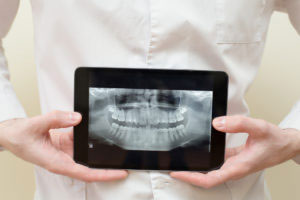Digital X-Rays: More Safe & Necessary Than You’d Expect
Digital X-Rays Safety in West Chester, PA
Like any good parent and/or spouse, you want to make sure that your family is getting the dental care they need. Keeping one’s teeth healthy is integral to so many parts of life, it’s a wonder that more people don’t take regular dental visits seriously.
 Of course, there may be some concerns that come to mind. How might your kids or spouse react to dental treatment? Are all of these treatments safe? Does your dentist use traditional or digital X-rays? What will your insurance pay for? Will the dentist listen to your concerns?
Of course, there may be some concerns that come to mind. How might your kids or spouse react to dental treatment? Are all of these treatments safe? Does your dentist use traditional or digital X-rays? What will your insurance pay for? Will the dentist listen to your concerns?
You may also have heard that some of the diagnostic tools used by dentists can expose patients to unnecessary risks, such as a certain amount of radiation. It is wise to check with a dental office about what they use and how often.
But what if we told you that at least one of your worries can be easily solved by going to a dentist that uses digital X-rays?
Why Do We Need Dental X-Rays?
Let’s begin by telling you the truth about dental X-rays. People pretending to be experts might tell you that it’s not necessary to have X-rays taken by your dentist or hygienist. They often reason that the dentist is just trying to get money out of you. Horror stories about the radiation causing cancer are passed around for shock value. You don’t know who to trust on the issue.
However, the reality is that you can trust when a dentist tells you that you need dental X-rays if you want to be aware of the true condition of your mouth. Bone loss and periodontal disease cannot always be detected without an X-ray. And that root canal you’ve been avoiding? It will never be dealt with without X-rays.
Eluding an uncomfortable treatment may seem appealing until that tooth needs to be pulled because of neglect. In truth, you’d be more likely to avoid further pain by getting a simple digital X-ray done rather than evading the dentist.
Digital X-Ray vs Traditional X-Ray
Traditional X-rays were created in 1895 by a German physicist named Wilhelm Rontgen. The famous first X-ray was taken of Rontgen’s wife’s hand. Just like many other diagnostic tools, the uses branched from one area of the body to many; including the teeth.
Some other relevant facts about traditional X-rays are:
- An average millisievert (mSv) of radiation from film-developing dental X-rays are about .052 mSv and you get about 3.00 mSv just living life, out in the natural world.
- There are 2 main types of dental X-rays, intraoral (X-rays taken from the inside of the mouth, such as bitewings and periapicals) and extraoral (X-rays taken from the outside of the mouth, like panoramic images).
- Traditional X-rays are still more commonly used because of convenience. Buying a new machine and training staff how to use a digital X-ray machine can be viewed as costly and disruptive to an office.
- If that amount of radiation exposure with standard X-rays is still an issue for you, wait until you hear about the digital X-rays West Chester dentist Drs. Dave Montgomery and Ryan Dunn have been using for many years now!
- Digital X-rays radiation exposure is more than 80% less than a traditional X-ray.
- Digital X-rays are beneficial to you and the dentist because of the immediacy of film processing. Diagnosis can happen much more quickly.
- Digital X-rays can be stored much more effectively with digital archiving.
- With digital X-ray software’s ability to change the saturation, contrast and image size, dentists are able to easily identify problem areas, whereas traditional X-rays don’t provide that benefit.
- Traditional films use processing chemicals that have to be disposed of each month. With digital X-rays, there are no chemicals which can be a hazard to the environment.
Suggested Frequency of Digital X-Rays
There are patients whose dental histories may require more visits to the dentist and also necessitate additional digital X-rays. According to the American Dental Association and the U.S. Food & Drug Association patients who will need more frequent digital X-rays are:
- Smokers and Chewing Tobacco Users – Smoking, in general, stimulates bone loss in the jaw. The sweetener in chewing tobacco can cause more cavities. Both making diagnosis with digital X-rays necessary.
- Children and Teenagers – Keeping track of the development of adolescent teeth is made easier with digital X-rays. Those children/teenagers who are more prone to having more cavities will require digital X-rays every 6 months.
- Adults with a history of cavities – Just as a dentist would monitor children and teenagers with cavities or other recurring dental issues, adults need monitoring as well. Any history of decay requires the use of digital X-rays for future diagnosis.
Choose CCFD as your Trusted Location For Digital X-Rays
Don’t let hearsay and anxiety get in the way of you or your family members receiving excellent dental care. You can visit our website to learn more about our team, what our patients are saying about us, and the services and procedures we offer our patients.
If you have further questions about digital X-ray safety or any other dental need, please give Chester County Family Dentistry a call!